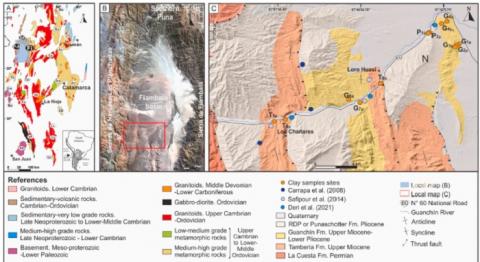Virginia V. Reinoso Carbonell, Gilda Collo, Cecilia A. Wunderlin, Pablo H. Alasino, Patricia L. Ciccioli, Sebastian Rocher, Santiago Maza
2 022
Journal of South American Earth Sciences 118 (2022)
Clay mineral characterization is a valuable tool for unraveling the evolution of continental sedimentary basins. The Fiambala ´ basin is a foreland Andean basin located in the Southwest of the province of Catamarca (Argentina), on the flat subduction segment. In order to characterize its paleoenvironment and post-depositional evolution, petrographic, X-ray diffraction (XRD), and scanning microscopy (SEM-EDS) studies were carried out in detrital and volcaniclastic samples from the Tambería, Guanchín, and Rodados de la Puna Fms. Petrographic and XRD analyses show a predominance of phyllosilicates, quartz, plagioclase, and low proportions of feldspar and anhydrite, sporadic calcite, analcime, heulandite, and hematite. In the XRD fraction <2 μm, minerals from the smectite and illite groups dominate, with lower proportions of chlorite and kaolinite. An analyzed tuff level presents smectite solely in this fraction. The textural-compositional analyses of SEM-EDS show that illite and chlorite have a detrital origin. Their preservation would be consistent with the dominance of an arid climate in the region during the erosion and deposition of material from the source areas. The smectites are of the magnesium-rich beidellite-montmorillonite type and, together with the zeolites would be authigenic as a product of the alteration of both the volcanic material and magnesian detrital phases (chlorite and biotite), possibly under the influence of an alkaline environment related to the arid climate. From a thermal point of view, the presence of smectite throughout all stratigraphic succession allows interpreting maximum temperatures that, even in the deepest levels of the basin, inhibit the development of prograde phases (such as smectite/illite and smectite/chlorite mixed-layered) and allow the preservation of smectite. Based on the authigenic clays present in the basin, paleogeothermal gradients of between 13 and 18 ◦C/km (considered a fill of 4000 m thick) and between 8 and 11 ◦C/km (considered a fill of 6000 m thick) could be estimated.

